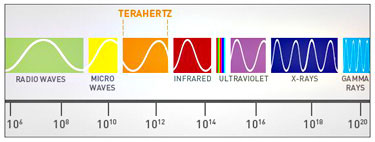
X-ray vision won’t just be limited to comic book superheroes in the future. A team at the University of Texas at Dallas led by Kenneth O, Ph.D., professor of electrical engineering, has made new scientific advances that could make it possible for cameras to see through solid walls.

The researchers have designed a chip that could make it possible for the camera on a mobile device to see through walls, wood, plastic, paper — and even into the human body. This comes as the result of the linking up of two scientific advances: One taps into an unused range in the electromagnetic spectrum; the other is a new advance in microchip technology involving the terahertz band of the electromagnetic spectrum, which thus far has not been accessible via consumer devices.
“With focused effort, a product could be created within two years,” said O.
This is not the first technology to enable seeing through solid objects in real time. Last fall, researchers at MIT’s Lincoln laboratory devised a microwave-based see-through-walls technology.
“This is a very interesting area of research, and in some ways it is being driven by political necessity,” said Timothy Mack, president of the World Future Society.” The ability to have this technology has been getting a full-blown court press. There has been a lot of progress made in technology that can see through solid objects.”
Now You See Through It
Technology that will allow for non-superheroes to see through walls is thus seeing development in a number of sectors, including the military, with very different goals in mind.
“Essentially, I’m seeing parallel development,” Mack told TechNewsWorld. “On the one hand, there is the technology coming from the academic sector, while on the other hand, it’s coming from the military and the security sector. The military is looking at technology that can penetrate shield or stealth technology, and in that way it’s a weapons technology.”
What is coming from the private and academic sectors is a lot more subtle, emphasized Mack, who further stressed that there is not a lot of crossover in these technologies.
“At present, they are moving along in parallel, but with a similar role in mind,” he said — “that is, to see what was previously hidden from the naked eye. It was finding information that previously was only a guesstimate.”
Medical Possibilities
This advancement is possible because of developments in CMOS (Complementary Metal-Oxide Semiconductor) technology, which serves as the basis for most electronic devices today. Coupled with the terahertz development, this could create medical devices the size of a mobile phone. The researchers at the University of Texas see a potential for this technology to be used in place of X-rays.
It’s possible because the computing power solutions are really off the charts.
“This could give us a full picture of what we previously could not see, or could only get partial glimpses of,” said Mack. “It’s now exponentially more possible.”
Due to privacy concerns, O and the other researchers have limited the depth this technology can penetrate.
“The approach we are taking … will have limited range of 10 cm (4 inches) or less,” O told TechNewsWorld. “We believe this can largely mitigate the privacy concerns.”
These limitations in the range of the technology could also limit its possibilities for medical applications — but not necessarily.
“Even being able to see 4 inches in the body could be dramatic,” said James Canton, Ph.D., of the Institute for Global Futures. “It will allow those emergency responders to see injuries in ways that have not previously been possible.”
Additionally, factoring in Moore’s law, what is 4 inches today could be 10 to 20 inches in just four years, said Canton. And this could open up the possibility of greater medical uses.
“It could have uses in MRIs to see more of the brain, and 4 inches would allow deep scans within the brain. 4 inches would allow the stomach lining to be seen. This opens the possibility to be able to see deep into the body.”
Privacy Concerns Remain
While the researchers have so far looked to put limits on this technology, others may not.
“If you can manipulate it, this opens up many privacy concerns,” said Lilie Coney, associate director at the Electronic Privacy Information Center. “The temptation is there, and the limitations are really not relevant.”
There is considerable doubt that this technology would be safe from manipulation.
“There are huge privacy concerns, as all new technology gets hacked,” said Canton. “Whatever the initial uses, they get hacked and used in other ways. There are dozens and dozens of technologies where this occurred.”
While the depth may be limited to 4 inches today, it is not hard to imagine how this technology could be used to spy on people through walls.
“The privacy concerns will be addressed when we consider security and safety,” said Mack. “In many cases when there is a health risk, especially in children, privacy often goes out the window. If it comes down to saving a life, privacy does not win.”





















































